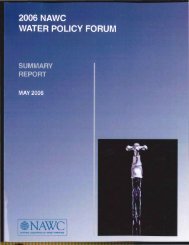BEECHER - NAWC
BEECHER - NAWC
BEECHER - NAWC
Create successful ePaper yourself
Turn your PDF publications into a flip-book with our unique Google optimized e-Paper software.
Water ComparedIndustries ComparedooooooooooAs a natural resource, water raises substantial environmental issues. Water utilities areexpected to serve as environmental stewards by providing source protection andconserving water resources.Because the service population is physically exposed to water, through ingestion andinhalation, water also raises substantial public health issues related to drinking waterstandards, as well as wastewater management and fire protection.Culturally, water issues are taken very personally. Constituents sometimes view water asan entitlement and the process and cost of safe, adequate, and reliable water service iseasily unappreciated.The corporate culture in the water sector is not highly competitive, but rivalrous in termsof ownership form (public v. private). Entrepreneurial opportunities are limited.Managers tend to be cautious and place a high emphasis on safety and reliability.The economic development interests associated with water are highly localized. Localgovernments often use water and wastewater systems as tools of growth and development.Water resources are controlled through complex but often disjointed systems of rights,permits, and markets. Markets and market-based pricing for water resources are highlyimperfect, mainly because of historic distortions in water development.The technical, economic, and institutional barriers to market entry are substantial.Drinking water regulations constitute a formidable market barrier. Political barriers toentry (namely opposition to privatization) are very prevalent, particularly with regard tochanges in ownership; the barriers are less substantial for contract operations.For the water industry, the playing field for competition is uneven due to the currentstructure of the industry, the competitive advantages of public ownership in terms oftaxation and financing options, and wide variations in jurisdiction and application of stateand local regulation.For the telecommunications and energy industries, the movement toward competitionprovides a relatively cohesive policy paradigm. For the water industry, no unifyingparadigm for restructuring has emerged.Policy goals for the water industry are diverse and complex. Leading goals on the policyagenda include compliance with drinking water quality standards, replacement of theinfrastructure, regionalization to achieve economies of scale, and resource protection andconservation.In the following analyses, data are used to highlight differences among the utility industriesalong the following key institutional dimensions:o System sizeo Ownership structureo Economic regulationo Public policies<strong>NAWC</strong> 43 September 1998
















